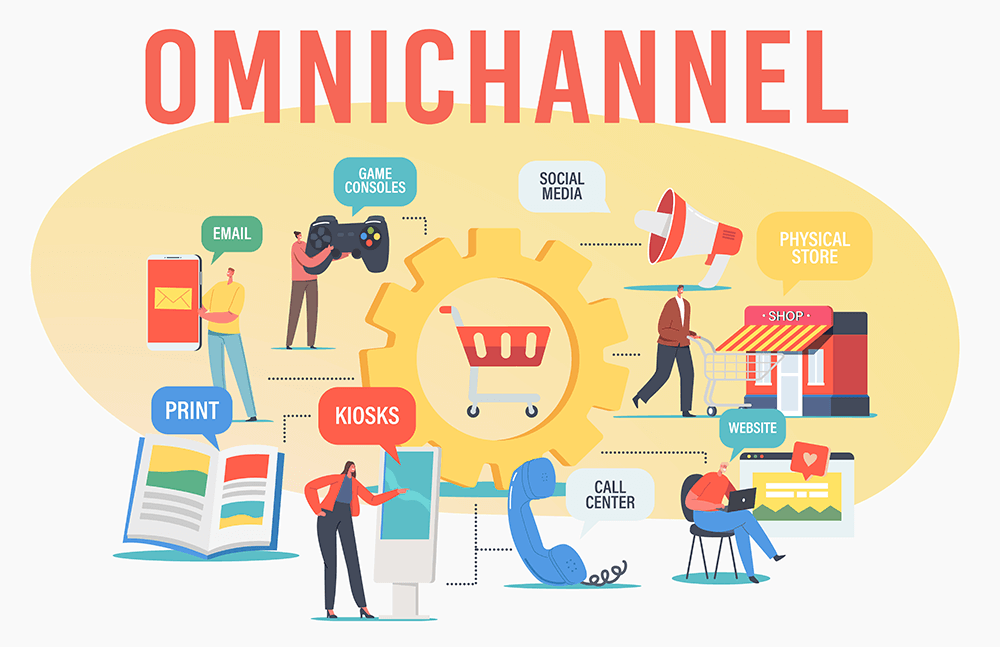
Whether you’re dreaming of creating your own multi-vendor marketplace or already have one up and running, embracing omnichannel marketing strategies is your key to unlocking the best possible benefits.
This rings especially true given the fiercely competitive landscape of the marketplace industry. Currently, there are over 200 million online shoppers worldwide – a number that continues to grow at a steady pace year after year. Projections indicate that by 2023, 17% of all transactions will be conducted through online stores or marketplaces.
So, how can you position your platform as a go-to destination for consumers?
Many multivendor marketplaces use different marketing channels – such as social media, email, and web content – to attract potential customers at various points in their journey. While these multichannel marketing tactics are a great start, they may inadvertently leave room for inconsistencies between engagements. For instance, a customer might have a stellar engagement on social media, but that could be their sole interaction with your brand.
Achieving a consistent experience requires something a little extra. It requires omnichannel marketing strategies.
What Are Omnichannel Marketing Strategies?
First, let’s define what “omnichannel” means.
Omnichannel is a customer-centric marketing approach that brings together all the places your brand exists – from physical stores to websites to apps – to create a unified and steady brand experience. This way, customers can smoothly bounce between online and offline channels without feeling like they have to start their interaction over.
A frequently employed omnichannel strategy involves enabling customers to place orders online and pick up their purchases in-store. This lets customers seamlessly progress through their journey, switching between multiple channels while still moving towards their destination.

Therefore, omnichannel marketing is the process of seamlessly blending branding, messaging, and online and offline touchpoints throughout the consumer journey. This creates a more impactful customer experience.
By prioritizing a consistent and positive consumer experience, omnichannel marketing strategies include key elements such as:
- Maintaining a consistent brand vision and tone
- Personalizing messages based on individual interests
- Tailoring content to reflect past interactions and the buyer’s current position in their journey
An easily recognizable brand, coupled with personalized content, increases the likelihood of consumer engagement across various channels.
Why Do Multivendor Marketplaces Need Omnichannel Marketing Strategies?
A successful omnichannel marketing strategy brings multiple benefits to any online marketplace. While it may push your marketing team at the beginning, the rewards make their efforts more than worth it.
Simply put, omnichannel marketing strategies lead to happier customers, increased revenue, and more opportunities to reach your target audience.
With that in mind, let’s explore the benefits of omnichannel marketing strategies in greater detail:
1. Improved Customer Experience
Digital customers crave consistency from their brands. Thankfully, developing omnichannel marketing strategies allows you to create a better and more integrated shopping experience.
This is big because the buying experience is increasingly becoming a core motivator for making a purchase:
- Positive experiences make it more likely that customers will return.
- Good experiences lead to social sharing with six or more individuals.
- It only takes two to three negative experiences to make customers reject your brand entirely.
The easier it is for customers to engage with your brand on any channel, the more likely you’ll leave them with a lasting, positive impression.

2. Wider Reach
Do you want to reach your target audience? Then you have to be where they are, and research shows that they’re bouncing around quite a bit.
More users are online than ever before, and there are more digital channels for them to choose from. Consumers use an average of almost six touchpoints when buying an item. 50% use more than four.
The numbers are similar on the business side of things. When teams use three or more channels in their marketing campaigns, they see a 287% higher purchase rate than companies that use single-channel campaigns.
3. Increased Revenue
Consistent customer experiences have been tied to a greater number of purchases and a higher ticket price.
Research indicates that 86% of buyers don’t mind paying more for an item if they have a great experience. Furthermore, 49% say that they’ve made impulse purchases because of some sort of personalized experience.
Omnichannel marketing allows you to keep creating these experiences, so customers keep spending. It’s why companies using omnichannel strategies see 250% greater purchase frequency than single-channel campaigns and an AOV that’s 13% higher.

4. Enhanced Customer Lifetime Value
This probably won’t shock you, but customer retention rates go up with omnichannel options. After all, when you give people what they want (a consistently good experience), they tend to stick around. At least, that’s what the research shows.
Omnichannel strategies bring in 90% higher retention rates than their single-channel counterparts.
When you have customers consistently increasing their spending with each purchase over an extended period, it naturally leads to a higher customer lifetime value. Additionally, you save on acquisition costs and efforts. Remember: selling to an existing customer is always easier than acquiring a new one.
5. Competitive Advantage
The secret is out on omnichannel marketing strategies. Unfortunately, only a few companies have capitalized on the opportunity.
61% of customers still have a hard time switching between channels for the same brand. In addition, 87% of shoppers believe brands should put greater effort into creating a seamless experience for buyers.
Most customers feel like they’re missing something with their brand engagement. Giving them what they’re asking for will push them right to your business.

5 Best Omnichannel Marketing Strategies For Multivendor Marketplaces
So, we’ve established that omnichannel marketing strategies are crucial for marketplaces. Now, it’s time to learn how you can take advantage of this approach to drive your e-commerce venture’s growth.
Here are five great strategies to start with:
1. Have a Variety of Purchasing Options Across Channels
Not all customers want to visit your website to make a purchase. Some opt to order directly from the social media app that they’re scrolling through, while others prefer visiting an in-person location. Then, there are those who seek a combination, allowing them to order online but pick up the product in a physical space.
An omnichannel approach offers customers the flexibility to choose any of such options, helping them move through different channels as they desire.

2. Never Make Customers Restart Their Journey
Bouncing between various marketing channels can cause customers to lose the progress they made in one interaction after they moved to the next.
Unfortunately, starting and stopping this way disrupts the flow of the buyer’s journey. It could potentially cause them to reconsider or, worse, abandon the purchase entirely. It can be frustrating to start from scratch on a different channel after investing time shopping on another.
Implementing omnichannel strategies helps reduce the friction of channel hopping during the shopping experience. By saving cart information to the customer’s profile, they can seamlessly pick up where they left off, regardless of the channel they’re using.
There are other ways to implement this concept, as well. For example, Crate & Barrel takes it a step further by offering seamless registry additions. Basically, this allows users to receive real-time updates on any device without losing progress when moving to another one.
3. Utilize Data to Know What Your Customers Want
Data rules just about everything in e-commerce. The more you know about your customer behavior, the more you can show up where and when they need you.
For marketplaces, that means monitoring the success of your vendors and seeing what will help them succeed. A good customer relationship management (CRM) tool or sophisticated plugins can help you access all sorts of customer information.
You can also try to get customer data by
- Encouraging them to get feedback from customers
- Building surveys for vendors to send out
- Understanding all the channels their customers use
- Surveying vendors about their customer’s behavior
Getting your vendors to understand their customers will allow you to help them succeed on your platform, which leads to your success, too. Once you have the data, you can strategize the best ways to reach customers on multiple channels.

4. Have a Consistent Brand Across Every Platform
Customers should never doubt who you are and what you represent.
The more channels you incorporate in your overall strategy, the easier it can be to let some slip through the cracks. Maybe your Instagram isn’t as active as your Facebook, or you have a haphazard app on the market because you just wanted to get something out there. Unfortunately, these types of inconsistencies can cause long-term problems with your customers.
Remember: you want to instill trust in your customers on all your channels. Thus, you should always show that your brand is professional, well-organized, cohesive, and consistent no matter how someone chooses to engage with it.
A few simple tips that will help you offer these experiences include:
- Keeping imagery and design consistent
- Using similar messaging
- Updating content regularly
- Managing all accounts from one platform
5. Make Things Personal
Personalization is one of the major trends currently on the minds of nearly all e-commerce marketers.
Impersonal experiences frustrate customers, and most are willing to share information about themselves to get more personal engagement. 80% of consumers are more likely to spend their money on brands that offer them those kinds of personal experiences.
Omnichannel marketing takes that desire for personalization seriously. Its customer-centric approach enables consumers to shop and engage with brands the way they want to. In short, it gives them control over the customer journey.
Companies can use omnichannel marketing strategies to appeal to that personal nature. Each channel gives a fresh option to personalize an experience. As that personal experience extends from one channel to the next, customers will feel more connected to your brand and choose you when it comes time to make a purchase.

Conclusion
The multi-vendor marketplace industry has grown immensely in the last few years, and it’s showing no signs of slowing down. To thrive in such a competitive landscape, marketplaces must take advantage of omnichannel marketing strategies.
Omnichannel marketing strategies let online shopping hubs offer customers enhanced, more personalized experiences that lead to:
- Improved customer loyalty
- A wider reach
- Increased revenue
- Enhanced customer lifetime value
- A competitive advantage
Here are five tried-and-tested omnichannel marketing strategies any marketplace can benefit from:
- Have a variety of purchasing options across channels
- Never make customers restart their journey
- Utilize data to know what your customers want
- Have a consistent brand across every platform
- Make things personal
Do you have any questions about omnichannel marketing strategies? Reach out to us and let us know!
And if you’re looking for a marketplace management platform that will grow with you as you increase your customer base, check out a free demo of WC Vendors. We’d love to help you build and manage the best marketplace possible!